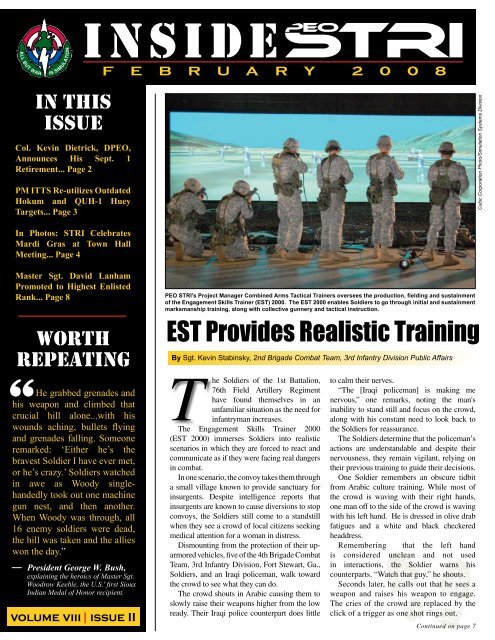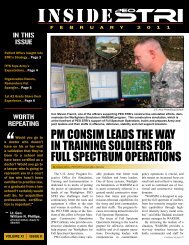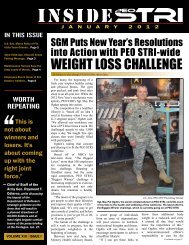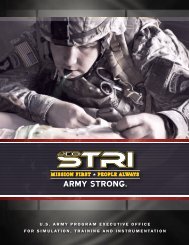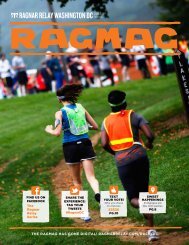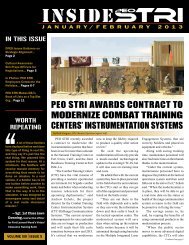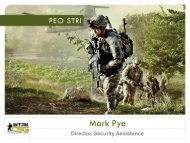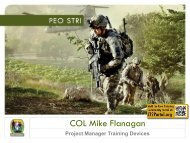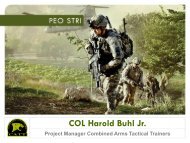You also want an ePaper? Increase the reach of your titles
YUMPU automatically turns print PDFs into web optimized ePapers that Google loves.
In this<br />
Issue<br />
Col. Kevin Dietrick, D<strong>PEO</strong>,<br />
Announces His Sept. 1<br />
Retirement... Page 2<br />
PM ITTS Re-utilizes Outdated<br />
Hokum and QUH-1 Huey<br />
Targets... Page 3<br />
<strong>inside</strong><br />
F E B R U A R Y 2 0 0 8<br />
Cubic Corporation Photo/Simulation Systems Division<br />
In Photos: <strong>STRI</strong> Celebrates<br />
Mardi Gras at Town Hall<br />
Meeting... Page 4<br />
Master Sgt. David Lanham<br />
Promoted to Highest Enlisted<br />
Rank... Page 8<br />
Worth<br />
Repeating<br />
He grabbed grenades and<br />
his weapon and climbed that<br />
crucial hill alone...with his<br />
wounds aching, bullets flying<br />
and grenades falling. Someone<br />
remarked: ‘Either he’s the<br />
bravest Soldier I have ever met,<br />
or he’s crazy.’ Soldiers watched<br />
in awe as Woody singlehandedly<br />
took out one machine<br />
gun nest, and then another.<br />
When Woody was through, all<br />
16 enemy soldiers were dead,<br />
the hill was taken and the allies<br />
won the day.”<br />
President George W. Bush,<br />
explaining the heroics of Master Sgt.<br />
Woodrow Keeble, the U.S.' first Sioux<br />
Indian Medal of Honor recipient.<br />
volume viii issue II<br />
<strong>PEO</strong> <strong>STRI</strong>'s Project Manager Combined Arms Tactical Trainers oversees the production, fielding and sustainment<br />
of the Engagement Skills Trainer (EST) 2000. The EST 2000 enables Soldiers to go through initial and sustainment<br />
marksmanship training, along with collective gunnery and tactical instruction.<br />
EST Provides Realistic Training<br />
By Sgt. Kevin Stabinsky, 2nd Brigade Combat Team, 3rd Infantry Division Public Affairs<br />
he Soldiers of the 1st Battalion,<br />
76th Field Artillery Regiment<br />
have found themselves in an<br />
unfamiliar situation as the need for<br />
infantryman increases.<br />
The Engagement Skills Trainer 2000<br />
(EST 2000) immerses Soldiers into realistic<br />
scenarios in which they are forced to react and<br />
communicate as if they were facing real dangers<br />
in combat.<br />
In one scenario, the convoy takes them through<br />
a small village known to provide sanctuary for<br />
insurgents. Despite intelligence reports that<br />
insurgents are known to cause diversions to stop<br />
convoys, the Soldiers still come to a standstill<br />
when they see a crowd of local citizens seeking<br />
medical attention for a woman in distress.<br />
Dismounting from the protection of their uparmored<br />
vehicles, five of the 4th Brigade Combat<br />
Team, 3rd Infantry Division, Fort Stewart, Ga.,<br />
Soldiers, and an Iraqi policeman, walk toward<br />
the crowd to see what they can do.<br />
The crowd shouts in Arabic causing them to<br />
slowly raise their weapons higher from the low<br />
ready. Their Iraqi police counterpart does little<br />
to calm their nerves.<br />
“The [Iraqi policeman] is making me<br />
nervous,” one remarks, noting the man's<br />
inability to stand still and focus on the crowd,<br />
along with his constant need to look back to<br />
the Soldiers for reassurance.<br />
The Soldiers determine that the policeman’s<br />
actions are understandable and despite their<br />
nervousness, they remain vigilant, relying on<br />
their previous training to guide their decisions.<br />
One Soldier remembers an obscure tidbit<br />
from Arabic culture training. While most of<br />
the crowd is waving with their right hands,<br />
one man off to the side of the crowd is waving<br />
with his left hand. He is dressed in olive drab<br />
fatigues and a white and black checkered<br />
headdress.<br />
Remembering that the left hand<br />
is considered unclean and not used<br />
in interactions, the Soldier warns his<br />
counterparts. “Watch that guy,” he shouts.<br />
Seconds later, he calls out that he sees a<br />
weapon and raises his weapon to engage.<br />
The cries of the crowd are replaced by the<br />
click of a trigger as one shot rings out.<br />
Continued on page 7
Col. Kevin M. Dietrick<br />
Deputy Program Executive Officer for<br />
Simulation, Training and Instrumentation<br />
Fellow <strong>STRI</strong> Employees:<br />
Recently the <strong>Army</strong> approved my retirement date of Sept. 1, 2008. My decision to<br />
retire came after careful thought and deliberation with my family about how I might<br />
continue to contribute to our nation, and with Dr. Blake about what is best for the<br />
<strong>PEO</strong>.<br />
This year, as I enter my 30th year in the <strong>Army</strong>, I wanted to select a retirement date<br />
that lined up with Dr. Blake’s ability to select a qualified replacement for the deputy<br />
position. The summer timeframe represented the best opportunity for him to do that.<br />
My career, like that of most Soldiers, has been one of mostly one, two and three year<br />
assignments, with every assignment offering growth, opportunity and rewarding<br />
experiences. This assignment at <strong>STRI</strong> is unique in that I have been here for six years,<br />
with one deployment, and culminating with my assignment as your deputy <strong>PEO</strong>. I<br />
cannot think of any better way to cap off my career in the <strong>Army</strong>.<br />
We at <strong>STRI</strong> still have much to do in the coming months, but I wanted to take this<br />
opportunity to formally announce my plans, and to tell you how much I have enjoyed<br />
working with you as part of this magnificent organization.<br />
Mission First, People Always!<br />
Kevin M. Dietrick<br />
Colonel, U.S. <strong>Army</strong><br />
2<br />
Inside <strong>STRI</strong> FEBRUARY 2008
PM ITTS Targets Management Office<br />
Finds a New Use for Outdated Targets<br />
By Eric Hoffman, <strong>PEO</strong> <strong>STRI</strong> Project Manager Instrumentation Targets & Threat Simulators, Security Officer<br />
<strong>PEO</strong> <strong>STRI</strong>’s Targets Management<br />
Office (TMO), located at Redstone<br />
Arsenal, Ala., has provided testing<br />
targets to the Department of Defense (DoD)<br />
and contractors for many years. TMO has<br />
acquired and created many different types<br />
of targetry for meeting the demands of the<br />
DoD community.<br />
Two such targets, the Hokum and a fleet<br />
of QUH-1 Huey drones, have outlived their<br />
usefulness as viable assets for TMO. With<br />
changing technology and new mission<br />
requirements, the need to carry a fleet of<br />
rotary wing aircraft has greatly diminished.<br />
TMO started looking at ways to reutilize<br />
the targets. The Hokum, an AH-1<br />
Cobra modified to simulate a Russian attack<br />
helicopter, found a home in the White Sands<br />
Missile Range (WSMR) Museum. The<br />
museum collects displays of projects that<br />
have impacted the history of the range.<br />
“The WSMR Museum is very pleased<br />
to have the Hokum target helicopter,”<br />
said Darren Court, museum curator. “Its<br />
importance, once it is placed into Missile<br />
Courtesy Photo<br />
Project Manager Instrumentation Targets and Threat Simulators discovered a revised utilization for two targets<br />
that no longer meet the mission requirements. One of the two types of targets, the QUH-1 Huey drone pictured<br />
above, will be transferred to the 5th Armored Brigade to provide pre- and post-mobilization training.<br />
Park, is that it will allow our museum visitors<br />
to see just how the Targets Branch can take<br />
C E L E B R A T I O N H E A L T H<br />
Courtesy Photo<br />
A team of <strong>PEO</strong> <strong>STRI</strong> employees visited the Nicholson Center for Surgical Advancement in Celebration,<br />
Fla., Feb. 22. The Center, a teaching hospital affiliated with UCF's new medical school, is focused on<br />
advanced robotics surgery and will be the home of many surgical simulators. Pictured from left to right:<br />
Col. Craig Langhauser, project manager for Combined Arms Tactical Trainers, Maj. Dave Thompson,<br />
assistant product manager for Medical Simulation Training Centers, Dr. Vipul Patel, robotic surgeon<br />
at Celebration Health, Roger Smith, chief technology officer for <strong>PEO</strong> <strong>STRI</strong>, Dr. Richard Satava, special<br />
assistant in Advanced Surgical Technologies at the <strong>Army</strong> Medical Research and Materiel Command,<br />
and Rick Wassel, director of the Nicholson Center.<br />
a U.S. vehicle and modify it to resemble a<br />
Soviet vehicle, providing realism in missile<br />
testing. It will be a welcomed addition to<br />
the WSMR Museum's collection of target<br />
vehicles."<br />
Eleven Huey drones will be transferred<br />
to the 5th Armored Brigade. The brigade,<br />
stationed at Fort Carson, Colo., is a reserve<br />
training task force providing pre- and postmobilization<br />
specific training to reserve and<br />
active duty units. Accepting the aircraft<br />
on behalf of the 5th Armored Brigade was<br />
Chief Warrant Officer 3 Don Kolesar.<br />
“With the transfer of the Hueys, the<br />
brigade will be able to provide Soldiers with<br />
realistic training in Medevac procedures,”<br />
he said. The helicopters will be placed at<br />
the unit’s training ranges at Fort Bliss.<br />
“These actions have ensured that the<br />
Hokum will not be forgotten and the Huey<br />
drones will provide the Warfighter with<br />
the opportunity to train on real equipment,<br />
ensuring success on the battlefield,” said<br />
Al Brown, acting director for TMO. “At<br />
the same time we have eliminated the cost<br />
of keeping the aircraft in a serviceable<br />
condition. It is a win for the all parties.” <br />
Inside <strong>STRI</strong> FEBRUARY 2008 3
4<br />
Inside <strong>STRI</strong> FEBRUARY 2008
IRS Stimulus Package Rebate:<br />
Exactly How Much Will You Receive?<br />
By Laura Cushler, Associate Counsel<br />
On Feb. 13, President Bush signed<br />
into law the $168 Billion Economic<br />
Stimulus Act of 2008. Part of<br />
the package includes tax rebate checks for<br />
most Americans. The basic rebate amount<br />
is the lesser of net income tax liability, or<br />
$600 ($1200 for married couples filing<br />
jointly).<br />
This applies if and only if:<br />
1.<br />
2.<br />
the taxpayer has $3,000 in qualified<br />
income (earned income, social<br />
security, railroad retirement, and/or<br />
veterans benefits)<br />
OR<br />
the taxpayer has a gross income<br />
greater than the basic standard deduction<br />
plus one exemption (two exemptions<br />
for married couples filing<br />
jointly) AND the taxpayer has a net<br />
taxable income of at least $1, then<br />
the taxpayer qualifies for the minimum<br />
rebate amount of $300 ($600<br />
for married couples filing jointly)<br />
plus an additional $300 per child.<br />
Since this rebate is an advance for a new<br />
credit that will be included on the 2008<br />
1040 income tax form, it will not affect<br />
your 2007 taxes. In April 2008, you will<br />
receive what you are owed, or you will<br />
have to pay what you owe, as if the rebate<br />
never occurred.<br />
This summer you will receive the rebate<br />
for the 2008 credit as calculated above. In<br />
April 2009 or thereabouts, when you file<br />
your taxes for 2008, the IRS will run the<br />
calculation for the stimulus rebate credit<br />
again.<br />
If the results show that you would have<br />
received more (due to an additional child,<br />
for instance), you will be sent the difference.<br />
If your results show that you would have<br />
received a smaller rebate, then you get to<br />
keep the difference. This is an additional<br />
credit. You do not have to pay back to the<br />
IRS what you will receive this summer.<br />
Receiving this advance will not reduce<br />
next year’s refund nor will you owe more<br />
federal tax.<br />
Here is the Scoop:<br />
1. The rebate is only available for eligible<br />
taxpayers! A taxpayer is ineligible<br />
if he or she can be claimed as a<br />
dependent on someone else's return,<br />
or if he or she is a nonresident alien.<br />
2. For taxpayers with an adjusted<br />
gross income less than $75,000, or<br />
$150,000 for married couples filing<br />
jointly. The basic or minimum rebate<br />
amount is reduced by five percent of<br />
the adjusted gross income more than<br />
those amounts.<br />
3. The rebate is an advance credit<br />
against your 2008 tax return, which<br />
will be filed in 2009. It is calculated,<br />
however, based on the amounts<br />
shown on your 2007 return (which<br />
will be filed in 2008). When you file<br />
your 2008 return, the IRS will recalculate<br />
your rebate based on the 2008<br />
amounts. If this results in a larger<br />
rebate amount, you will receive a refund<br />
of the difference. If this results<br />
in a smaller rebate amount, you will<br />
not have to repay the difference.<br />
4. The rebate will not increase or decrease<br />
any tax refund to which you<br />
would otherwise be entitled. It is an<br />
additional credit for 2008, which<br />
you are receiving in advance. To receive<br />
a rebate (which the IRS is now<br />
calling a "stimulus payment") you<br />
MUST file a 2007 tax return, even<br />
if you are not otherwise required to<br />
file.<br />
For a simple way to figure out your rebate,<br />
see http://www.kiplinger.com/tools/<br />
rebate/. <br />
Inside <strong>STRI</strong> FEBRUARY 2008<br />
5
Even Just an Ounce of Prevention Is<br />
Worth More Than a Pound of Cure<br />
By Bill Osborne and Donnette Hart, Security Office<br />
We've all heard horror stories about<br />
fraud that's committed on us in stealing<br />
a name, address, Social Security<br />
number, and credit cards. Within a day thieves<br />
can order cell phone packages, apply for credit<br />
cards, have a credit line approved for major purchases,<br />
get a personal identification number from<br />
the Department of Motor Vehicles to change your<br />
driving record information online, and more.<br />
The following information could limit the<br />
damage in case this happens to you or someone<br />
you know:<br />
1. Instead of signing the back of your credit cards,<br />
print the words: "PHOTO ID REQUIRED" or<br />
“CHECK PHOTO ID.”<br />
2. When writing checks to make credit card payments,<br />
do not put the complete account number<br />
on the "For" or “Memo” lines, just write<br />
the last four numbers. The credit card company<br />
knows the rest of your account number and<br />
anyone who might be handling your check as<br />
it passes through the check processing channels<br />
will be denied access to your complete<br />
account number.<br />
3. Place your work phone number on your<br />
checks instead of your home phone. If you<br />
have a Post Office Box, use that instead of<br />
your home address. If you do not have a Post<br />
Office Box, use your work address. Also, never<br />
have your Social Security number printed<br />
on your checks.<br />
4. Take the contents of your wallet and place them<br />
on a photocopy machine. Copy both sides of<br />
each license, credit card, etc. Keep the photocopy<br />
in a safe place and you will always have<br />
a consolidated list of all your account numbers<br />
and corresponding phone numbers readily<br />
available if you ever have to cancel them.<br />
We’ve always been told we should cancel our<br />
credit cards immediately. The key is having the<br />
toll free numbers and your card numbers handy<br />
so you know whom to call. File a police report<br />
immediately in the jurisdiction where your credit<br />
cards, etc., were stolen. This proves to credit<br />
providers you were diligent.<br />
But here's what is perhaps most important of<br />
6 Inside <strong>STRI</strong> FEBRUARY 2008<br />
all… Call the three national credit reporting organizations<br />
immediately to place a fraud alert on<br />
your name.<br />
CONTACT:<br />
Equifax: (800) 525-6285<br />
Experian (formerly TRW): (888) 397-3742<br />
TransUnion: (800) 680-7289<br />
The alert means any company that checks your<br />
credit knows your information was stolen and<br />
they have to contact you by phone to authorize<br />
new credit.<br />
We also recommend that you call the Social<br />
Security fraud line if you know your social security<br />
number may have been compromised at<br />
800-269-0271.<br />
Finally, we recommend that you carry a photocopy<br />
of your passport whenever you travel outside<br />
of the U.S.
EST 2000... Continued from page 1<br />
“Defend your actions,” flashes across the<br />
screen taking them out of their patrol and back<br />
into the safety of the dark training room.<br />
“People really get into it,” said Steve<br />
Brockwell, EST operator. “It's good for NCOs<br />
[non-commissioned officers] to train their<br />
people on.”<br />
One NCO taking advantage of the training is<br />
Sgt. 1st Class Chris LeMaire, gun truck platoon<br />
sergeant, Headquarters and Headquarters<br />
Battery, 1-76th Field Artillery Regiment.<br />
“This is a newly formed gun truck platoon,”<br />
he said, adding the battalion will soon be taking<br />
over responsibility of the area controlled by<br />
the 2nd Battalion, 69th Armor Regiment, 3rd<br />
Brigade Combat Team, 3rd Infantry Division.<br />
The EST 2000 unit is capable of a variety of<br />
tasks, including range training, weapon zeroing,<br />
and weapon familiarization, Brockwell said.<br />
Although some Soldiers might not take<br />
the concept seriously at first, once engaged,<br />
Soldiers quickly realize the system isn't just<br />
some over-the-top videogame system.<br />
“When you go down to the scenarios, we<br />
realize we can really do this for real,” said<br />
Spc. Nick Geno, a fire direction specialist with<br />
Headquarters and Headquarters Battery, 1-76<br />
Field Artillery. “It's not playtime anymore.”<br />
By immersing Soldiers in a virtual reality<br />
environment, where actors portray specific<br />
roles, wearing realistic garb, speaking in Arabic<br />
and working in an environment that could have<br />
been lifted from Iraq, the experience is quite<br />
lifelike.<br />
Adding to the realism are the weapons used<br />
by the Soldiers. They use their own weapons<br />
that are fitted with a special device that allows<br />
them to shoot a laser and interact with the<br />
Cubic Corporation Photo/Simulation Systems Division<br />
For the past two years, all <strong>Army</strong> basic trainees are required to qualify with<br />
their weapon on the EST 2000 before they are able to shoot live rounds on<br />
the firing range.<br />
imagery on the screen. The weapon retains the<br />
recoil of a live round, said Brockwell.<br />
Realism is also achieved by altering scenarios<br />
as they are run through by the Soldiers who<br />
train in five-man teams, said Sgt. 1st Class<br />
Raymond Linck, the EST NCO in-charge.<br />
“We can bump up or down the severity at<br />
any time to keep them on their toes,” he said.<br />
“They'll never know how the scenario will play<br />
out. It teaches situational awareness.”<br />
This feature prevents Soldiers who are<br />
watching from “cheating,” Brockwell said.<br />
With the press of a button, scenarios can change<br />
in a flash, just like real combat. One squad's<br />
previous walk through a local market could be<br />
uneventful while the next pass through could<br />
be full of insurgent forces.<br />
Besides this alteration, scenarios can also<br />
be tailored to a unit's individual mission needs,<br />
said Linck. Units more likely to patrol the<br />
roads can spend more time on convoy-based<br />
scenarios, while foot patrolling units can<br />
experience walking through towns, manning<br />
checkpoints or engaging locals in a market<br />
place.<br />
“Being artillery filling in for an infantry<br />
role, we're not used to some of these missions,”<br />
said LeMaire. “This training will help us be an<br />
efficient force.”<br />
“When we run through as a squad, it helps<br />
give us experience giving commands, working<br />
on our communication,” added Geno, who said<br />
improving communication is key. “This is a<br />
good refresher.”<br />
Though the EST 2000 was originally<br />
installed to help refresh the skills of the 5th<br />
Squadron, 7th Cavalry Regiment, 1st Brigade<br />
Combat Team, 3rd Infantry Division<br />
recently transferred<br />
under operational<br />
authority of the 2nd<br />
Brigade Combat<br />
Team, Linck said<br />
any unit can come<br />
work on the training<br />
system.<br />
“We are willing to<br />
work with any unit,”<br />
he said, noting that<br />
his home unit, the<br />
26th Brigade Support<br />
Battalion (BSB), 2nd<br />
Brigade Combat<br />
Team, 3rd Infantry<br />
Division, has used the<br />
machine extensively.<br />
“The whole BSB<br />
has been through,<br />
including the key leadership. They liked it a<br />
lot.”<br />
Even units and Soldiers who may never leave<br />
the base can get some good training out of the<br />
system. It can simulate weapon qualification<br />
ranges, allowing Soldiers to keep their shooting<br />
skills sharp without having to arrange for using<br />
a real range, getting ammunition, and providing<br />
the usual safety precautions, Brockwell said.<br />
“If you don't fire right on the EST 2000,<br />
you won't on the range. Here you can work on<br />
muscle memory, see where every bullet goes,”<br />
he said.<br />
“It's best to hit it right before the range,”<br />
Linck added, as it helps Soldiers familiarize<br />
themselves with their weapons and refresh<br />
their basic rifle marksmanship skills.<br />
Besides these advantages, the training<br />
system also has a large advantage for the <strong>Army</strong><br />
by decreasing the cost of training without<br />
decreasing the quality. “For five dollars of<br />
diesel you can run it for eight hours,” Brockwell<br />
said.<br />
In those eight hours, a Soldier can fire<br />
thousands of rounds. With live ammunition<br />
costing 28 cents a round, the savings really<br />
add up, Brockwell said, allowing the <strong>Army</strong><br />
to spend more money on equipment to keep<br />
Soldiers safer and more comfortable.<br />
Soldiers do not need to come as a unit.<br />
He said if a leader just wants to come down<br />
and train a Soldier on their weapon or a new<br />
weapon system, they can come by.<br />
On average, it takes a five man team 45<br />
minutes to run through each scenario, allowing<br />
Linck and Brockwell to accommodate up to<br />
100 Soldiers a day.<br />
“I think it will be very helpful for the FOB<br />
[Forward Operating Base],” Linck said of the<br />
training being offered.<br />
Watching the improvement in his Soldiers as<br />
they defend in the convoy scenario and go onto<br />
another scenario, this time in a marketplace,<br />
LeMaire can't help but agree.<br />
“What it does is it boosts the junior<br />
leadership,” LeMaire said. “It gives me a<br />
chance to evaluate my guys.”<br />
The evaluations, like the targets, are shown<br />
instantly on the screen. Already a marked<br />
improvement can be seen in the percentage of<br />
lethal shots fired and reaction time of Soldiers<br />
between the time they first see a threat to the<br />
time they respond to it.<br />
Even though the sights are virtual, the<br />
results are a reality, which LeMaire said he<br />
is glad to see. “I have a feeling that when<br />
they go outside the wire they'll have a lot of<br />
confidence.” <br />
Inside <strong>STRI</strong> FEBRUARY 2008 7
Intr oducing<br />
Sergeant Major<br />
David Lanham<br />
the<br />
Employee Sp o tlight<br />
By Kristen Dooley, <strong>PEO</strong> <strong>STRI</strong> Public Affairs Officer<br />
Sgt. Maj. David Lanham was promoted<br />
Feb. 29 to the highest enlisted rank in<br />
the U.S. <strong>Army</strong>.<br />
“The promotion enables me to enhance the<br />
ability of <strong>PEO</strong> <strong>STRI</strong> because I now have an<br />
increased accessibility to many levels within<br />
the <strong>Army</strong>,” Lanham said.<br />
Traditionally, Soldiers with the rank of<br />
sergeant major advise senior staff officers<br />
regarding matters concerning the enlisted<br />
personnel in their command.<br />
At <strong>PEO</strong> <strong>STRI</strong>, Lanham serves as the senior<br />
enlisted advisor to the program executive officer,<br />
Dr. Jim Blake.<br />
“Sgt. Maj. Lanham’s promotion to the most<br />
senior enlisted rank within the <strong>Army</strong> reflects<br />
highly not only on him, but also the entire<br />
<strong>PEO</strong>,” Blake said. “As an organization, we<br />
are proud of his success and recognize that<br />
his responsibility in the <strong>Army</strong> will help to take<br />
<strong>PEO</strong> <strong>STRI</strong> to the next level.”<br />
As a member of the executive staff, Lan-<br />
Courtesy Photo<br />
ham ensures that training devices continue to<br />
meet doctrinal and customer requirements in<br />
coordination with the appropriate proponent<br />
school, combat developer and user community.<br />
“My position affords me the opportunity to<br />
shape the way the <strong>Army</strong> is going in simulation<br />
and training,” Lanham said.<br />
For example, he was instrumental in<br />
creating the initial judgmental use-of-force<br />
scenarios in the Engagement Skills Trainer<br />
2000. “I used my experiences from Iraq,”<br />
Lanham said.<br />
Lanham has served multiple tours in Iraq<br />
and Afghanistan in support of Operations<br />
Iraqi Freedom and Enduring Freedom as a<br />
Special Forces senior sergeant.<br />
When Lanham is not working or training<br />
with his special operations unit with the<br />
Florida National Guard, he enjoys spending<br />
time with his family and working out at the<br />
gym. <br />
<strong>Army</strong> Sergeant Major Quick Facts<br />
The first U.S. <strong>Army</strong> sergeant major was appointed to the Continental<br />
<strong>Army</strong> in 1776.<br />
In 1920, it ceased to be a title of rank or grade when the <strong>Army</strong><br />
standardized the enlisted pay grades. It did, however, survive<br />
as the job title of the senior non-commissioned officer of a battalion.<br />
It was reintroduced as a rank in 1958 when Congress<br />
authorized E8 and E9 pay grades<br />
Hails<br />
Mark Dasher<br />
PM TRADE<br />
Randy Sookoo<br />
PSG<br />
Farewells<br />
Charles Farrior<br />
PSG<br />
Joy Hartley<br />
PSG<br />
Barbara Ladd<br />
Acq. Center<br />
Gladys Porch<br />
PSG<br />
Stay Tuned for March's Citizen <strong>STRI</strong>! To<br />
participate, answer the question:<br />
What has been your favorite Town Hall<br />
Meeting theme and why?<br />
Send your response to<br />
kristen.dooley@us.army.mil<br />
and put Citizen <strong>STRI</strong> in the subject line.<br />
Inside<br />
Inside <strong>STRI</strong> is an authorized publication for<br />
military and civilian members of the U.S. <strong>Army</strong><br />
Program Executive Office for Simulation, Training<br />
and Instrumentation, Orlando, Fla. 32826. Inside<br />
<strong>STRI</strong> is published under the authority of AR 360-1<br />
and applies the Associated Press Stylebook industry<br />
standard.<br />
Contents of Inside <strong>STRI</strong> are not necessarily<br />
the official views of, or endorsed by, the U.S.<br />
Government, Department of Defense, Department<br />
of the <strong>Army</strong>, or <strong>PEO</strong> <strong>STRI</strong>.<br />
Editorial material for publication should be<br />
submitted to <strong>PEO</strong> <strong>STRI</strong> Public Affairs Office, 12350<br />
Research Parkway, Orlando, Fla. 32826. The PAO<br />
reserves the right to edit all material submitted for<br />
publication.<br />
For more information about <strong>PEO</strong> <strong>STRI</strong> or to<br />
view Inside <strong>STRI</strong> online, visit our Web site at www.<br />
peostri.army.mil<br />
8<br />
The War Department, now the Department of Defense, changed<br />
the sergeant major insignia in 1959 to what you’ll see today.<br />
The insignia has three chevrons above three arcs with a five<br />
pointed star between the chevrons and arcs.<br />
Inside <strong>STRI</strong> FEBRUARY 2008<br />
Editor:<br />
Kristen Dooley<br />
Editor-in-Chief<br />
kristen.dooley@us.army.mil<br />
Design:<br />
Dwain Fletcher Co.<br />
CGgraphics@us.army.mil


